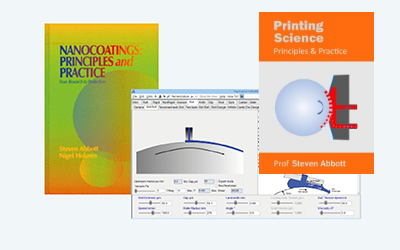Palierne Emulsion Rheology
Quick Start
This is an expert-level app. I wrote it mostly for myself when I was trying to understand emulsification in Offset printing. It calculates what happens to the rheology, G' and G'' when an emulsion is added to a resin which has its own Gr' and Gr'' properties.
Palierne Rheology
Surprising things can happen to the rheology, as measured by elastic modulus G' and loss modulus G'', when you add a low viscosity emulsion to a viscoelastic polymer, depending on the volume fraction φ of the emulsion, on the radius, R, of the emulsion drops and on the interfacial tension, σ, between them.
The equation, from Palierne1 is too complex to be shown here, including the literal sense that it contains complex numbers from which G' and G'' have to be extracted once the calculations are done. It has been argued by Pal2 that the volume fraction of emulsion used in the Palierne equation should be tweaked with reference to the close packing fraction and the Pal correction (using, for simplicity, φ m=0.64) is included in the app. Under most circumstances the viscosity of the emulsion drops makes little difference, so for simplicity it has been removed from the interface and set to 0.01 Pa.s.
Because the app, of necessity, uses a log-log plot, it is easy to think that the changes are modest. But for G' the changes can be large and unexpected.
The challenge for the user is to enter the Gr' and Gr'' values for the resin from which the calculated G' and G'' are derived. I have chosen a quasi-Prony approach with three exponential terms with three different frequencies, set as the start, end and geometric mean of the two. The start and end frequencies are the ωfrom and ωto inputs. The relative contributions of the low, medium and high frequency terms are controlled by the 3 sliders each for Gr' and Gr''. It is very easy for the low sliders to send the curves to (meaningless) negative values. If you have never had to specify a viscoelastic curve you will not appreciate that it is surprisingly hard to provide a simple, convenient method to specify generic curves (as opposed to ideal Maxwell curves).
The strongest effect is that the elastic modulus, G', can be increased significantly, at low frequencies, through the addition of an emulsion. However, at higher frequencies, the G' can be decreased The effect on G'' is generally smaller.
I wrote this app because of my interest in what emulsions do to offset inks. If the current app does not do what you need for your own application, let me know; I'll be happy to improve it.
1JE Palierne, Linear rheology of viscoelastic emulsions with interfacial tension, Rheol Acta 29:204-214 (1990)
2Rajinder Pal, A New Linear Viscoelastic Model for Emulsions and Suspensions, Polym. Eng. Sci., 48:1250–1253, 2008.


